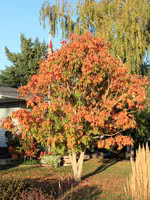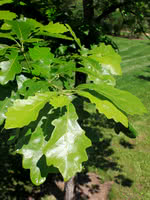Mon-Fri 9am - 5pm Mountain time
Bur Oak vs Ohio Buckeye
Aesculus glabra
Quercus macrocarpa
Ohio Buckeye is a medium sized deciduous tree. If you are looking for a shade tree, Ohio Buckeye's dense canopy of unique leaves can provide it.
Named after its fruit, an inedible nut enclosed in a prickly husk, Ohio Buckeye also features green-yellow flowers and long, broad leaves that turn brilliant red in the fall.
Slow growing, but an extremely attractive tree. Find out what experienced horticulturalists already know: this tree is a gem.
A top CO2 absorbing species. Experts think this tree may help climate change more than others.
Bur Oak has a wide distribution but is one of the only oaks that will grow well on the prairies. Bur Oak produces deeply lobed, dark green leaves that turn golden yellow to brown in the fall.
Its acorns are round and half enclosed by a mossy fringed cup.
Although slower growing, this long lived tree eventually becomes a popular large ornamental tree for driveways, parks, and the front of industrial buildings. Popular as a memorial or dedication tree.
Note: Most Oak species can be considered toxic for many animals.
Ohio Buckeye Quick Facts
Bur Oak Quick Facts
Toxicity: nuts are toxic to humans and cattle

